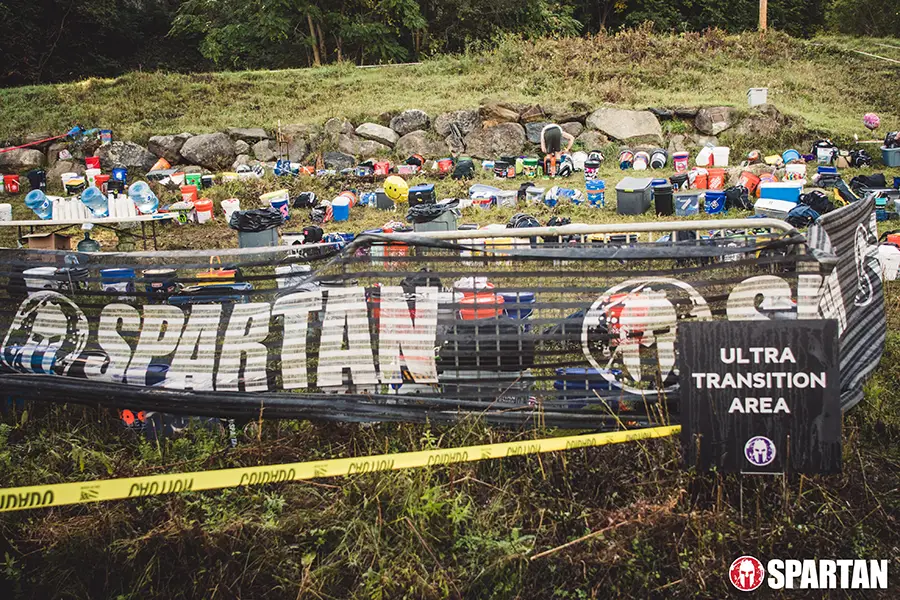You have a training plan. You’ve made travel arrangements. You’re putting in the miles. Now make sure that your transition bin is in check so that you nail your Spartan Ultra Beast!
Here’s my experience: I tried to run the Killington Ultra in 2019 as my first ultra race. I wasn’t quite ready and made some mistakes which led to me missing a cut-off time with about a mile to go. For a multitude of reasons, I decided to take 2020 off and came back in 2021 to finish the Killington and Tri-State Jersey Ultras. I even got third place in my age group at Killington! I learned a lot in that first failure and it made completing the next two races that much more satisfying. Hopefully, these tips will help you to be successful too.
Table of Contents:
- Race Packet pickup and preparing for the trip
- What should I bring to a Spartan Ultra Beast?
- Transition Drop Bins
- What is the transition area in a Spartan Ultra Beast?
- What are your goals in the transition area?
- My Spartan Ultra Packing List
- How many miles is a Spartan Ultra?
- How long do you have to finish a Spartan Ultra?
- Spartan Ultra Rules
- Tips for finishing a Spartan Ultra Beast
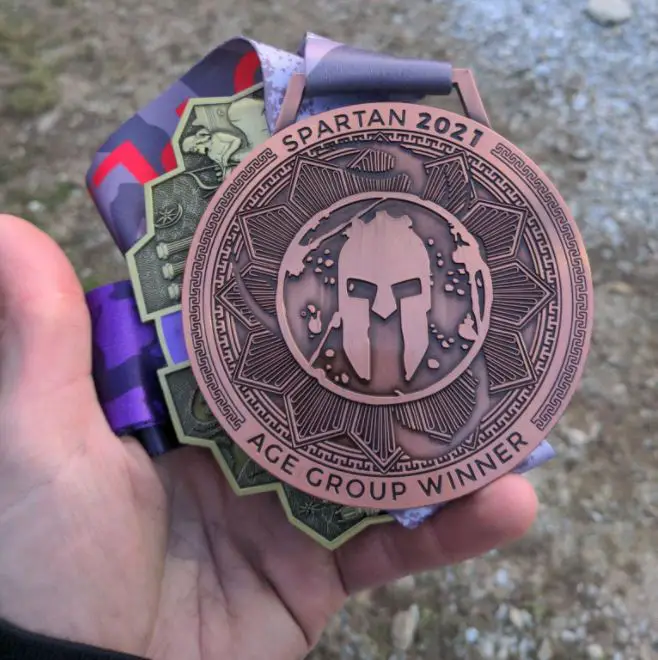
Race Packet pickup and preparing for the trip
If you’ve received your race day program, you’ll see that there’s a “mandatory” race packet pickup the night beforehand. The fact is, it’s not really mandatory from my experience. But I’m personally a fan of getting there the day before. If you’ve never been to the venue it gives you a chance to figure out where everything is; find the bathrooms, find the start line, and find the transition area. Anything you can do to make the race morning go more smoothly, the better. Even if you have been to the venue before, it’s helpful to see if the venue layout has changed and you can get a good spot in the transition area.
When you’re running a race like Killington, getting a preview of the weather can be eye-opening. If you’ve traveled, the temperature change after driving only a few hours, plus being at a higher elevation, increased winds, etc. can be insightful and may change how you think about your gear choices. But as I said, I know plenty of people who arrived race day and had no issue getting their packet in the morning. My guess is that Spartan tries to get as many people ready the day before because the Ultra races start so early and they usually don’t have full staffing by then.
What should I bring to a Spartan Ultra Beast?
If you’re running an Ultra, hopefully, you’ve run at least one Spartan race beforehand so you have some idea of what to expect. But Ultras are unique and have their own requirements. Generally speaking, you’ll need to bring clothing, gear, food/hydration, and a transition bin to be prepared for before, during, and after the race.
Clothing considerations for an Ultra Beast
What you wear can have a pretty big impact on how you race.
Before the race
If you’re running your race in the summer, it should make preparations a lot easier. You might be able to show up in shorts and a t-shirt and be fine. If your race is in the shoulder seasons, it becomes a little more difficult. You’ll want to wear something to keep your muscles warm for as long as possible before the race. I had sweatpants and a hoodie on before both of my races until about 2 minutes before I had to get enter the corral.
During the race
What to wear during your race is extremely personal and could be an article of its own. The advice I’d give is that you should be racing in the clothing you train in, and training in the clothes you race in. You should go into the race knowing that the gear you have will perform because you’ve been using that gear for weeks or months beforehand. Also, research the weather for a week or two beforehand to see if you’ll want to bring additional layers beyond what you’ve needed to train in. If you haven’t been training in those additional layers, now’s your chance to test it out. For me, if it’s above freezing I can get away with running and shorts and a t-shirt, but usually, I wear gloves and a windbreaker until I’m warmed up. This is exactly how I started out at Killington and dropped the gloves and windbreaker at the transition.
The hardest thing to plan for is coming out of the water obstacles. It’s one thing to run in cold weather – it’s another to get wet and then try to run! If your run with a vest, you can always add or shed layers as you go, and if you’re really worried about it, you can keep your layers in a ziplock bag to ensure they stay dry. If you’ve gotten to the venue and realized that it’s colder than you expected – don’t panic! You can always find a trash bag and cut holes for your arms and head. It sounds ridiculous, but the plastic will stop wind and keep your core warm until you recover from the water. Plus they are lightweight.
After the race
If you’ve run a Spartan race before, you know that you’ll want a towel and a change of clothes for afterward. By the time I got my medals and t-shirt at Killington, my teeth were chattering. When your body is that depleted, it’s harder for your body to keep itself warm. At both races, I changed into the sweatpants and hoodie that I wore before the race, plus some clean underwear and socks.
Gear considerations for an Ultra Beast
Just like your clothing, you should be training with the gear that you plan to race in.
Shoes
By now you should know your shoes well. I bring a second pair of shoes to keep in my transition bin just in case something happens, or to wear after the race. Luckily, I’ve never needed the second pair. You might also want to bring a second pair of socks. I haven’t bothered to change socks mid-race, but some racers do.
Hydration system
The other thing to consider is your hydration system. Do you run with a bladder on your back, or do you prefer bottles on a waist pack? By now you should have put in plenty of miles with your hydration system and know that it will be comfortable for the entire race. I suggest wearing it for at least one run a week leading up to race day. You should be testing it out on your long runs to make sure it doesn’t chafe and so you can practice using it. I also suggest running with it occasionally on shorter runs just to get used to the added weight.
I personally prefer a running vest and have run several Beast races with a $30 vest I bought online. I’ve since upgraded to a Salomon Advanced Skin 5 which I’ve been really happy with. It’s no longer available, but this is a very similar product. If you’re using a bladder with a drinking tube, I like to get one with a cap on the mouthpiece to help keep it free from dirt and mud.
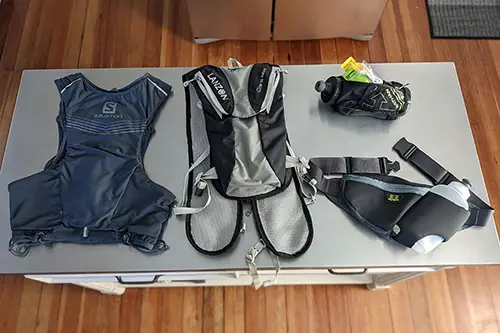
Headlamp
A headlamp is usually part of the mandatory gear list put out by Spartan. There is definitely a chance that you will need to use one. I ran with one for the first hour or so of the New Jersey Ultra, and I ran with one for the last 2 hours of my first attempt at Killington. I can’t imagine trying to run through the single tracks at Killington without having a headlamp on! Luckily, in my second race there I didn’t need it at all, but some people preferred to start with a headlamp since the sun hadn’t fully risen. If you’ve never run through the woods at night I highly suggest it. It’s a very unique experience and you’ll want to try running with the headlamp on beforehand. Some guidelines for picking one: 30 lumens minimum to walk, 150 minimum to run, 300 lumens to run comfortably. Make sure it’s waterproof or keep it in a ziplock bag.
Watch
I typically train with a watch and like to race with one too. It doesn’t necessarily have to be anything special – a cheap watch will still allow you to track your time to make sure you are staying on schedule.
First aid/blister care
I always make sure to carry something to take care of blisters while out on a run. It’s usually just duct tape or Leukotape to cover hot spots before they become blisters. I find if you address them early, they don’t become an issue. I also sometimes carry Body Glide to hit areas that are rubbing and to cover the tape I use to protect the hot spots.
At New Jersey, the trail ran directly over a hornet’s (bee, wasp?) nest. I was running with one other guy and we both got stung several times. After the race, I heard that a lot of people got stung and I had a stronger reaction than I’ve ever had before. I’ll always carry a couple of Benadryl pills on me after that experience. If you’re someone who’s allergic to bees make sure you run prepared.
Food and Fueling considerations for an Ultra Beast
The guideline I personally used for my races was 100 calories every 45 minutes, plus the calories from hydration (covered below). This might be on the lower end of what’s recommended – I’ve read you should be aiming for 200-400 calories an hour. The good news is that you can recover quite a bit during your transition, you just need to make sure you get there!
Fueling is something you should definitely be training for well before the race. You’ll want to know what foods sit well in your stomach while running, and which ones don’t. I find that I do better alternating gels with something solid, otherwise, the sweetness of the gels becomes sickening. I do find that towards the end of the race when you are least hydrated, eating something like a Clif Bar can be very difficult when you’re breathing heavy. In the transition area, I eat all of the solid foods that are too difficult to run with. I always bring something salty and carb-heavy like potato chips, and a Snickers bar which can melt during your run. I like to wash it down with something carb and caffeine heavy like a mini can of Mountain Dew. Some people bring along foods like burritos, soup broth, and peanut butter and jelly sandwiches which achieve the same goal. It all comes down to preference.
Water
This is another factor that’s best answered by what you’ve learned in training. Hopefully, you’ve experienced different temperatures and durations of runs and have an idea of how much water you need. In both of my races, I carried about 1L of water and I drank at least one cup at every aid station. I only had to add a little water to my bladder on my second lap of one race. Killington and New Jersey both had 19 aid stations for the Ultra runners according to the race day programs.
I suggest some sort of electrolyte mix in your water that has calories as well. Just like food, I prefer something that doesn’t taste sweet because it becomes sickening over the course of an entire day. I’ve been using Tailwind and have been really happy with it.
Transition Drop Bins
Don’t wait until the night before to pack it! Make sure everything fits ahead of time. I started to gather stuff a week beforehand so I had plenty of time to think of all the things I wanted to bring and make sure all of my race day clothes were clean and ready to go.
Drop Bin Size
I haven’t seen anything in writing from Spartan about transition bin sizes, and the fact is that I’ve never seen anyone checking. I’ve heard bins must be less than 7.5 gallons, but haven’t been able to find that on the Spartan website or in my race day programs. The majority of racers will use a 5-gallon bucket from Home Depot. This worked fine for me at all of my races, but I had it packed to the brim. Many racers choose square or rectangular bins so that you aren’t digging around to find what you need. I can see an advantage to this, but if you deliberately pack your bucket and use ziplock bags to organize it, a bucket works fine. If you need more than 7.5 gallons, you should probably reconsider your packing strategy.
What is the transition area in a Spartan Ultra Beast?
Spartan Ultras are usually two laps of the Beast race, with some bonus loop or loops to extend the mileage. Somewhere around the halfway point, the race will take you through the festival area and you’ll be able to access your transition drop bin. This is your time to refuel, refill, and address any issues. This is also where most people drop out of the race, so it’s important to have a strategy for when you get there.
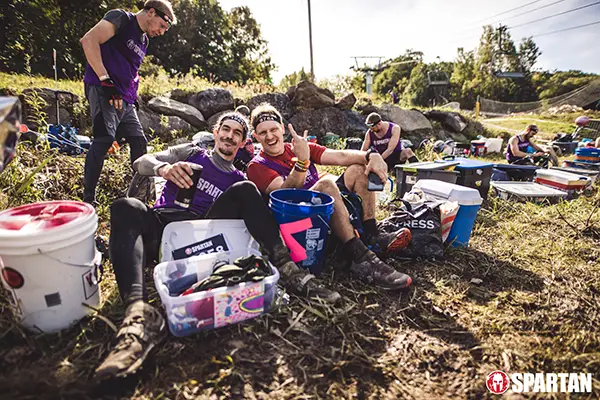
What are your goals in the transition area?
You should go into the race knowing exactly what your goals are for the transition area. This is something that you can, and should, practice beforehand. It’s not a bad idea to write down a list of things to do while you’re in the transition and tape it to the underside of the cover. Who knows what mental state you’ll be in at that point! You’ll generally want to use this time to:
- Refill water
- Dump food wrappers
- Grab the fuel you need for the remainder of the race
- Treat any hot spots or chafing areas.
- Change any problematic clothing
Anything you can do beforehand to make the transition quicker, the better. Here are some tips:
- Some people will have a second bladder or additional flasks, prefilled with water and an electrolyte mix, to quickly swap them out in transition. I premix my water in a plastic bottle so I can top off the bladder that I carry.
- I separate my food into different Ziplock bags that I label so I know exactly what I need to carry and what is meant to be eaten at the transition. Even if I have food left over from the first lap, it all comes out. Then I take what’s in that ziplock bag and put it in my running vest. All of the calculations for how many calories I’ll need during the second lap will be done beforehand so I’m not trying to do anything on the fly.
My Spartan Ultra Packing List
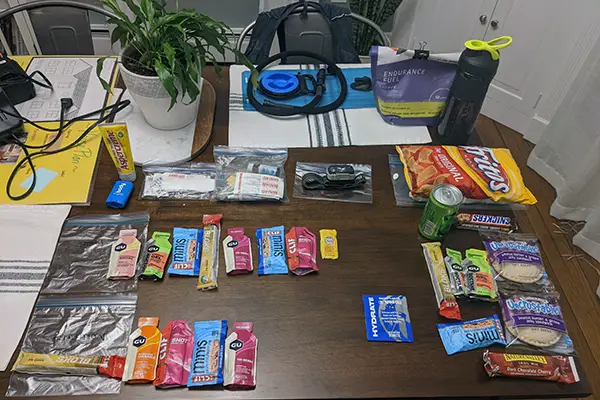
This will vary based on the weather, personal preferences, etc. Both races I ran started in the high 30’s and got up to the low 60’s. There was no rain in the forecast. Here is my packing list.
What I wore or carried:
- Salomon Advanced Skin 5 (this is similar)
- 2 liter bladder (filled half way with electrolyte mix)
- Headlamp – Black Diamond Spot 350 in ziplock
- Fuel – gels, mini Clif Bars, Clif Bloks, mustard packet
- First aid ziplock – blister tape, safety pin, alcohol pad, blister bandage, etc.
- Windbreaker – I like the Patagonia Houdini
- Gloves
- Trash bag poncho (got nervous at Killington but never needed it)
In my transition bin:
- Pre-portioned ziplock with food to refill my vest
- Pre-portioned ziplock with food to eat in the transition
- Water pre-mixed with electrolytes
- Salt pills
- Body Glide for any hot spots
- First aid kit – check out this article for an in-depth look at how I prepare for long runs or multi lap trail races
- Extra pair of shoes and socks
- Warm clothing from before the race to change into afterwards
- Sandals for afterwards
- Towel
- Plastic bag for the muddy gear afterwards
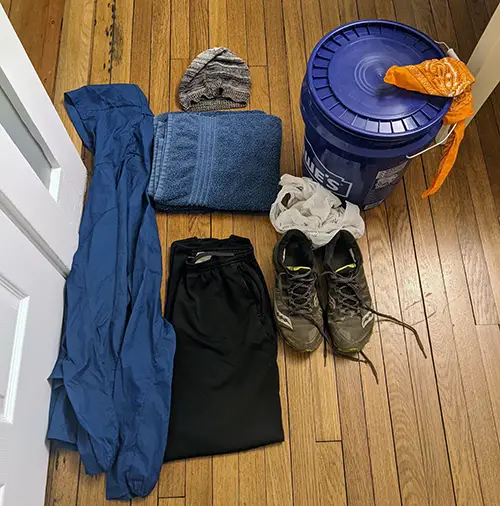
How many miles is a Spartan Ultra?
Spartan states that the Ultra Beast as a 50k, or 31-mile, race. Once you factor in penalty loops, bucket carries, sandbag carries and any other obstacle that doesn’t count towards the mileage, it’s usually around 32 miles.
How long do you have to finish a Spartan Ultra?
You technically have between 12-13 hours to finish the race, but the more important question is “when are the cut-off times along the way”. Every race varies from year to year, and location to location. About a week before the race, you should receive a race packet in your email that will give you all of this information. The race map will usually come out one or two days beforehand. They usually do a Facebook live session for questions and venue-specific info. Here are examples from the two races I ran:
2021 New Jersey start times and cut off times
6:00am Ultra Elite Men & Women Start
6:15am Ultra Age Group Start
6:30am Ultra Open Start Times Begin
Head Lamp Cut off Times
(meaning that staff will be checking to see if you are carrying a headlamp, which is mandatory)
Ultra Transition Area – at mile 17.0 – 1:30 PM
Water Station #4 – at mile 23.17 – 4:45 PM
Course Cut Off Time
Ultra Transition Area – mile 17.0 – 2:30 PM – This would give you 8 hours to make it 17 miles in the open wave.
Water Station #4 – Mile 23.17 – 5:45 PM – This would give you 11 hours 15 minutes in the open wave.
Full Course Closure 9:00 PM
2021 Killington start times and cut off times
6:00am Ultra Men’s & Women’s Elite Start
6:15am Ultra Age Group Start
6:30am Ultra Open Heats Begin
2:00pm: Any Ultra Racer who has not passed through the Transition area by this time will be removed from course. This was around mile 18.
4:00 pm: Any racer on the course must have a working headlamp on them. If you do not have a headlamp, you risk being pulled from the course.
5:00 pm: Any Racer who hasn’t passed Bender by this time will be removed from the course.
6:30 pm: Any Racer who hasn’t passed Spearman by this time will be removed from course.
Spartan Ultra Rules
Just like any other Spartan race, if you’re running age group or elite, you should know the rules ahead of time and adhere to them. Some examples: Certain obstacles are mandatory completion. No running with headphones. You need to end the race with the gear you started with as well as complete any obstacle with all the gear you’re carrying (like wearing your hydration vest under the dunk wall). You’re also not supposed to receive any help from your friends or family spectating, other than cheering of course. If you’re running open wave many of these rules don’t apply. You can download the official rules here.
Tips for finishing a Spartan Ultra Beast
- Show up to the start line healthy. I know this is much easier said than done, but make sure you’ve given yourself adequate time to taper and make sure that you’re addressing any injuries early on during training.
- Keep moving! This is a tip you’ll hear everywhere: just keep moving. And it’s true. If you can’t run, then jog. If you can’t jog, then hike. If you can’t hike then walk. But don’t sit down.
- Don’t start too slow. This was a mistake I made in my first race. The fact is that a huge percentage of the people you’re starting an ultra race with will not finish. If you get stuck behind people in the back, they are likely the people who will not finish. Race day, we showed up to the race late and hopped in the corral seconds before the race started. This meant that we started at the very back of the pack. We fell into a groove at a pace that caused us to play catch up the entire time.
- Hydration. Just like any other race, hydrating well in advance will set you up for success. I won’t tell you exactly how much you should be drinking, but you should be pre-hydrating. Hopefully you’ve prepared for your long efforts in training as if it was a race so you have a sense of how much you should be drinking.
- Training plan. Do research and create a training plan. You don’t have adhere to it perfectly, but it should map out months of training volume to get you ready safely. Make sure that it includes long days that will get you used to an entire day of racing.
Are you training for a Spartan Ultra? Have you raced one? Tell us about it in the comments!

